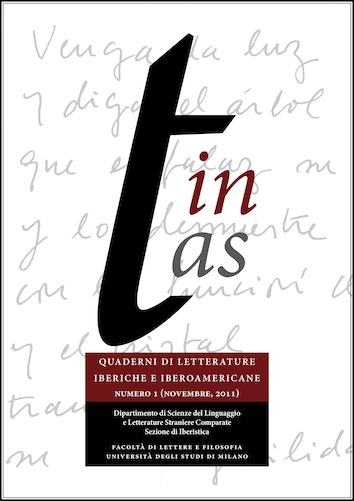Villena e Febrer sulle soglie dell’Inferno
DOI:
https://doi.org/10.13130/2240-5437/1808Abstract
Lo studio prende le mosse dalla contemporanea apparizione di due traduzioni della Divina Commedia nella Penisola Iberica: la prima in prosa castigliana, per opera di Enrique de Villena, nel 1428, la seconda in endecasillabi catalani, firmata da Andreu Febrer nel 1429. Dopo aver analizzato la genesi delle due versioni, sono stati messi in evidenza i metodi impiegati dai due traduttori, che risultano strettamente dipendenti dal diverso obiettivo che si erano prefissati: Febrer pare intenzionato a creare un’opera letteraria in qualche modo autonoma, mentre lo scopo della traduzione spagnola sembra essere stato quello di fornire un testo a fronte per facilitare la lettura dell’originale con un "supporto". Il confronto delle soluzioni via via adottate permette di far emergere i possibili contatti tra Villena e Febrer durante l’elaborazione delle loro opere, ipotizzabile a partire dalla comune formazione giovanile nell’ambito della corte catalana. Data la vastità delle opere, lo studio è stato condotto prendendo come punto di riferimento il canto III dell’Inferno e, più in generale, la prima cantica. Alla luce di quanto analizzato, sembra plausibile ipotizzare che la versione castigliana poté servire in qualche caso a Febrer e non viceversa. The first translations into a vernacular language of Dante’s Divina Commedia were carried out in 1428 and 1429: the first, in Castilian prose, signed by Enrique de Villena; the second in Catalan verse, that is, hendecasyllabic tercets as in the original text, by Andreu Febrer. My aim in this study is to outline a short depiction of the cultural moment where they both dwelled in order to understand the relationship between their versions, so as to subsequently undertake an approach to both texts to assess the modus operandi they followed. Finally, I try to substantiate the hypothesis of a possible contact between both writers while each of them was at work on his translation. As far as Febrer is concerned, his aim seems to have been to create a somehow autonomous literary work, while the purpose of the Spanish translation appears to have been to present a parallel text as a support for an easier reading of the original one. Since their aims are not the same, it follows that the outcome of their work cannot be compared from the stylistic point of view. Nevertheless, if we do compare them, we may understand more clearly the creative stance of both authors and, lastly, identify out the possible contacts between Villena and Febrer while they were at work on their versions. At the end of a first appraisal of the texts under examination it is possible to assume that, even if the Catalan poet knew Italian better, his translation was probably of no use to Villena precisely because of the excessive liberties the former took with the text and also due to his reiterated resorting to Italianisms and Occitanisms. On the contrary, the text in Spanish, precisely due to its different purpose, is far more likely to have been of some use to Febrer’s work. My impression, supported by a few examples, is that Febrer somehow managed to read his colleague’s work and that he in some instances drew on it. Given the extent of their work, to carry out my study I have decided to take the Third Canto of the Inferno, and especially the first stanza, as my point of reference.Dowloads
Pubblicato
2012-01-02
Fascicolo
Sezione
Articoli



